Revision Notes on Ecosystem for NEET 2025 - Free PDF Download
NEET aspirants who have completed Class 12 can now prepare for the exam with the use of revision notes created by Vedantu subject matter experts. Students can opt for Ecosystem Class 12 Notes for NEET that contain all the solutions and other aspects of the chapter. Many a times, students find it hard to understand the concepts directly from the textbook, which becomes difficult during the exam preparation time. Hence, these Ecosystem Class 12 notes are extremely beneficial for students to comprehend the topic well enough.
Ecosystem notes cover all the aspects of the chapter. By using notes, students will be able to understand the definition of the ecosystem, and in which it is divided into two. You can also download the Ecosystem Class 12 notes for NEET for free.
Furthermore, students will be able gain access to the knowledge of ecosystem components, factors, and other sections. One of the biggest benefits of using these revision notes is that you can enhance your preparation and give it the right direction for the NEET exam. Ecosystem PDF notes have easy explanations supplemented with diagrams and graphs.
Access NEET Revision Notes Biology Ecosystem
Introduction
The ecosystem is a key structure of nature wherein living organisms connect with one another and with their physical surroundings.
The biosphere is defined as a global ecosystem that consists of all of the world's local ecosystems.
Types of Ecosystems
There are several types of ecosystems that exist in nature.
These ecosystems include
Aquatic Ecosystems like ponds, wetlands, lakes, estuaries, rivers, and so on.
Terrestrial Ecosystems include forests, grasslands, deserts, and so on.
These are examples of natural ecosystems.
However, croplands, aquariums, and other man-made ecosystems are examples of artificial ecosystems.
Structure and Function of Ecosystem
An ecosystem comprises both biotic and abiotic factors.
Biotic Factors: This term refers to all living components or living beings of an ecosystem.
Abiotic factors: It includes all non-living aspects in an ecosystem such as sunlight, humidity, wind, and so on.
The physical layout of an ecosystem is determined by the relations between its biotic and abiotic factors.
Stratification is the vertical and horizontal distribution of various varieties that occupy various levels. In a forest, for example, trees dominate the highest vertical strata or layers, shrubs take up the second layer, whereas herbs and grasses inhabit the bottom layers.
The following factors are necessary for an ecosystem to function as a whole:
1. Productivity
2. Decomposition
3. The flow of energy
4. Nutrient cycling
An Ecosystem's Function is To Convert Inorganic Material Into Organic Material Through The Following Steps:
The use of solar energy by autotrophs.
A variety of heterotrophs consume autotrophs.
The decomposition and oxidation of all dead organic matter return nutrients to the soil for use again by autotrophs.
These occurrences occur repeatedly.
Energy moves unidirectionally as we move up the trophic levels. Energy vanishes and is lost to the environment as heat.
Consider the pond ecosystem.
Abiotic factors include water with all soluble inorganic and organic nutrients, nutrient-rich soil at the pond's rock bottom, solar input, day length, temperature, and many other climatic factors.
Producers or autotrophs in the pond include algae, phytoplankton, and aquatic plants.
Both free-living and bottom-dwelling zooplankton forms are examples of consumers or heterotrophs.
Fungi, bacteria, and flagellates are plentiful and cheap decomposers in the pond's bottom.
Productivity
A steady supply of solar energy is essential for any ecosystem.
Primary production is the quantity of biomass generated per unit area by plants through photosynthesis in a given time period.
It is measured in either weight (gm-2) or energy (kcal m-2).
Productivity is the rate at which biomass is produced. It is measured in gm-2 yr-1 or kcal m-2 yr-1.
An ecosystem's Gross Primary Productivity (GPP) is defined as the rate of organic matter yield during photosynthesis.
Net Primary Productivity (NPP) is defined as gross primary productivity (GPP) excluding respiration losses (R).
NPP = GPP – R
NPP is the freely accessible biomass for consumption by heterotrophs, herbivores, as well as decomposers.
Secondary productivity refers to the rate at which consumers create new organic matter.
Plant species and diverse natural factors determine the primary productivity of an ecosystem and thus vary from location to location.
Annual net primary productivity for the entire biosphere is roughly 170 billion tonnes (dry weight) of organic matter.
Despite covering nearly 70% of the earth's surface, ocean productivity is only roughly 55 billion tonnes.
Decomposition
Decomposition is the activity by which decomposers disintegrate complex organic compounds into simpler inorganic compounds like carbon dioxide, water, and nutrients.
Detritus is the dead remnants of plants and animals, including leaves, barks, flowers, animal faeces, and so on.
Detritivores are organisms that survive on detritus. Detritivores include earthworms, fungi, and other organisms.
Decomposition Procedure:
Fragmentation: The action of detritivores breaks down detritus into smaller particles.
Leaching: This is the process by which water-soluble substances seep down to the soil horizon and crystallize as inaccessible salts.
Catabolism: The operation of bacterial and fungal enzymes breaks down dead organic matter into simple inorganic nutrients.
Humification: The preparation and constant deposition of humus, a dark-coloured organic amorphous substance, is called humification. Humus is highly resistant to microbial operation and decomposes slowly. It functions as a nutrient tank because it is colloidal.
Mineralisation: The procedure in which certain microorganisms further degrade humus to produce simple inorganic nutrients.
Soil humification and mineralization occur.
On detritus, all stages of decomposition occur simultaneously.
Decomposition is primarily an oxygen-dependent process.
The decomposition rate is affected by both the chemical makeup of detritus and climatic factors. The decomposition rate is slower when detritus is high in lignin and chitin composition and faster when detritus is rich in nitrogen and water-soluble molecules like sugars.
Temperature and soil moisture are the two most prominent climatic factors in decomposition. They have an impact on the efforts of soil microbes.
Warm and moist climates favor decomposition.
Cold temperature and anaerobiosis (absence of oxygen) prevent decomposition. As a result, organic materials accumulate.
Flow of Energy
The Sun is the ultimate energy source for all Earth's ecosystems.
Photosynthetically Active Radiation (PAR): Solar radiation that plants can use for photosynthesis or synthesizing food is only 50% of the total incident solar radiation is PAR. Plants can only capture 2-10 % of the PAR, and it is the whole energy that nurtures all life on Earth.
The energy from the sun travels unidirectional, first to the producers and then to the consumers. As a result, all organisms rely on the sun directly or indirectly.
The First and Second Laws of Thermodynamics apply to all ecosystems.
The First Law of Thermodynamics states that energy can be transformed from one type to another in the presence of heat, internal energy, and work. However, energy can not be created or destroyed but can only be converted from one form to another.
The unidirectional energy flow demonstrates the First Law of Thermodynamics, as producers transform solar energy into chemical energy, which consumers then use. Energy cannot be created or destroyed at any level.
Second Law of Thermodynamics: According to the Second Thermodynamics law, the entropy of the whole universe as an isolated system will always rise significantly with time. The second law explains why changes in entropy in the world can never be negative.
Ecosystems need a continuous supply of energy to synthesize the molecules they need in order to mitigate the universal potential toward increasing disorderliness.
Food Chain:
A food chain is a form of energy transfer in the ecosystem.
A food chain is a sequence of the predation-based framework of species in an ecological system, in which each life form feeds on the life forms below it.
Producers: All green plants in the ecosystem use solar energy for photosynthesis. They are always autotrophic.
Consumers: All heterotrophs that rely on plants for nutrition, whether directly or indirectly, are considered consumers. Organisms are classified into primary, secondary, tertiary, and quaternary levels based on their position in the food chain.
An example of a terrestrial food chain is given below:
Grass → Grasshopper → Frog → Snake → Hawk
Primary Consumers/ Herbivores: Organisms that rely solely on the producers. Like the grasshopper is the primary consumer in the preceding food chain.
Secondary Consumers/ Primary Carnivores: Organisms that rely on primary consumers. The frog in the preceding food chain is an example of a secondary consumer.
Tertiary consumers/ Secondary carnivores: Organisms that rely on secondary consumers. For example, Snake in the given food chain.
Quaternary consumers/ Tertiary carnivores: Organisms that rely on tertiary consumers. They are usually at the top of the food chain, like the carnivore. Like Hawk in the given food chain.
There will not be sufficient energy left for another level organism if a food chain had more than a quaternary consumer.
Two types of food chains exist in an ecosystem. First one is the grazing food chain and the other one is the detrital food chain. The grazing food chain starts with grass but the detrital food chain begins with the dead organic matter that includes dead plants and animals.
Detritus Food Chain:
The starting point of the detritus food chain (DFC) is dead organic matter.
It is made up of decomposers, primarily fungi, and bacteria, both of which are heterotrophs.
To reach their energy and nutrient demands, they decompose dead organic matter or detritus. These are also known as saprotrophs.
Saprotrophs naturally produce digestive enzymes that break down the dead organic matter into simple or inorganic materials. The saprotrophs then absorb these simpler substances.
Detritus (Organic matter) → Saprotrophs → Inorganic nutrients
An example of Detritus Food Chain (DFC) is given below,
Dead organic matter → Earthworms → Black Bird → Hawk
Grazing Food Chain:
The Grazing Food Chain (GFC) is the primary pathway for energy flow in an aquatic ecosystem.
A large amount of energy transfers through the detritus food chain in a terrestrial ecosystem as compared to GFC.
The detritus food chain is linked to the grazing food chain because some DFC (Detritus Food Chain) organisms prey on GFC animals.
Omnivores, such as cockroaches and crows, can also be found in a natural ecosystem. These are the links between GFCs and DFCs.
Such a food chain is found in both terrestrial and aquatic ecosystems where the producers exist.
An example of Grazing Food Chain (GFC) found in a water body is
Phytoplankton → Zooplankton → Small fishes → Large fishes
Food web:
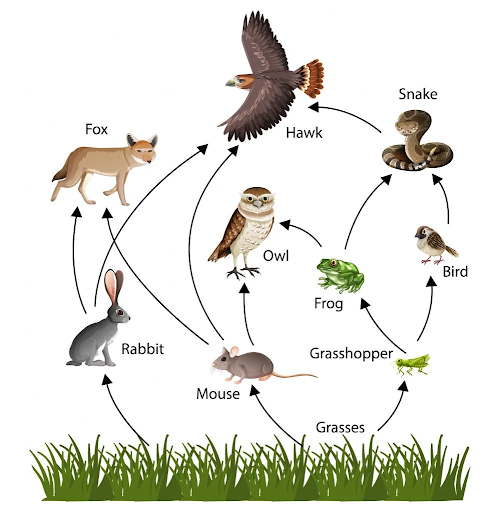
Food Web Representing Links Between Different Species of an Ecosystem
A framework of food chains that is interconnected and interdependent is termed a food web.
A food chain is a simple network that depicts the linear movement of energy and nutrients from one trophic level to the next. A food web is a network of interconnected food chains at various trophic levels. A food web also accurately represents all of the different food chains that appear in an ecosystem.
The food web is a suitable theoretical tool for depicting the feeding interactions among species within a community, showing species interactions and community composition, and interpreting the dynamics of transfer of energy in an ecosystem.
Trophic Levels:
The trophic level is the particular position in the food chain inhabited by an organism depending on the source of its diet or food.
Producers are at the top of the food chain i.e. First Trophic Level.
The primary consumers are at the second trophic level.
Secondary consumers are the third trophic level.
Tertiary consumers are the fourth trophic level.
The quaternary consumers are at the fifth trophic level.
A food chain can only have a maximum of five trophic levels because the total energy available is inadequate to maintain another consumer after that.
The quantity of energy decreases with each trophic level.
When an organism dies, it is transformed into detritus, which provides energy to the decomposers.
Standing crop is the total weight at a trophic level at a specific point in time. It is expressed as the living organism's mass (biomass) or the number of organisms in a given area.
Fresh or dry weight is another way to express biomass. However, using dry weight is more precise.
The 10% Law states that just 10% of the energy from one trophic level is converted to the next. It was given by Lindeman.
Lindeman’s 10% law states that only 10% of the energy stored in a lower trophic level is transferred to the next higher trophic level, with the remaining 90% being lost as heat.
Because the energy transfer in the food chain is limited, the number of trophic levels in the food chain is also limited. Only 10% of energy is transferred from one lower trophic level to the next trophic level.
The primary consumers (herbivores) do not receive 100% of the energy transfer from the producers like plants.
Similarly, plants also consume some of the sun's energy during the photosynthesis process.
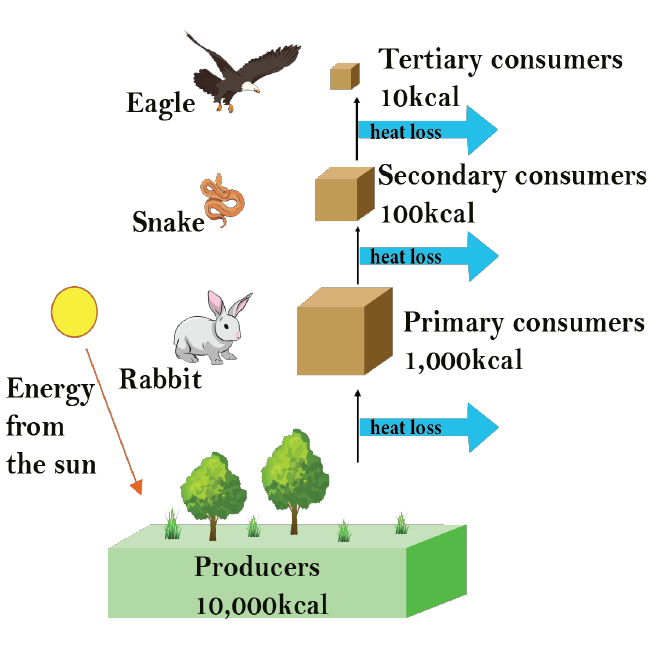
Food Chain
Ecological Pyramids
An ecological pyramid refers to a graphical depiction of the interactions among organisms in an ecosystem.
Also, every pyramid bar denotes a different trophic level and its order. The order is determined by who has been eaten by whom.
This also represents the flow of energy.
The base of each pyramid represents the producers or the first trophic level, while the apex represents the tertiary or top-level consumers.
The three most commonly analyzed ecological pyramids are as follows:
(a) Number pyramid
(b) Biomass pyramid
(c) Energy Pyramid
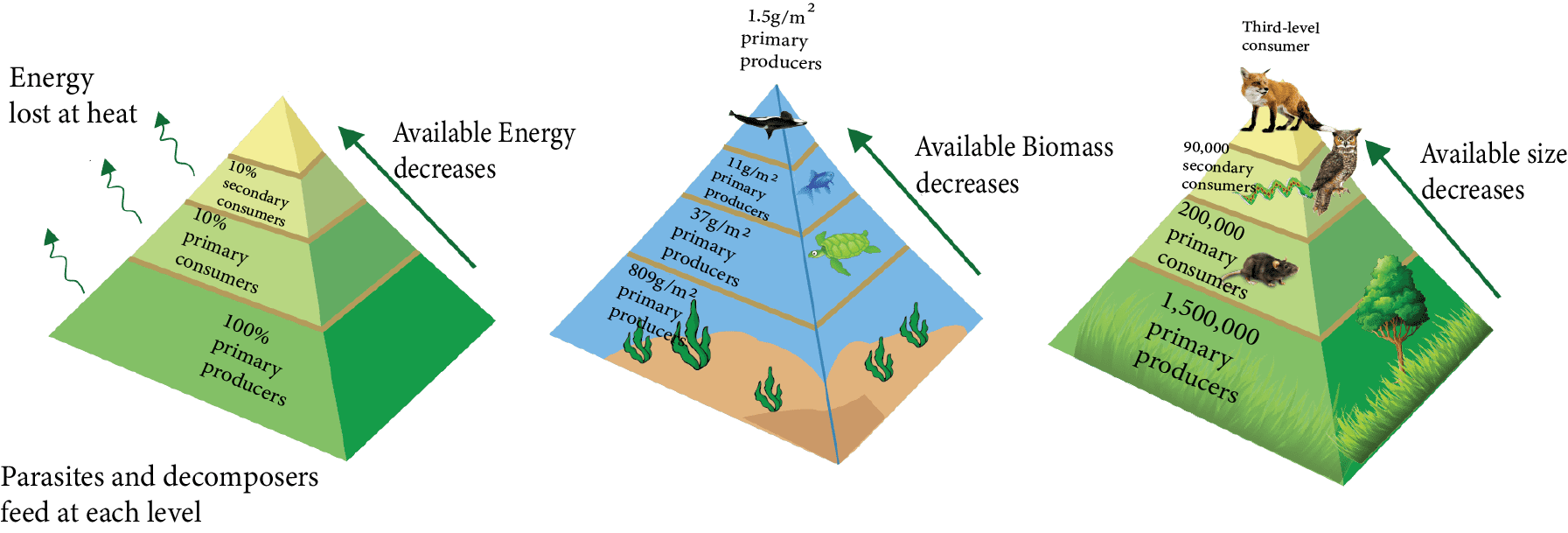
Ecological Pyramid
Any estimates of total energy, biomass, or population size should include all species at that particular trophic level.
It is difficult to generalize at any trophic level depending on only a few individuals.
An organism can contribute to more than just one food chain and thus to various trophic levels.
Ecological pyramids can only incorporate food chains, no food webs. They are also unable to represent saprotrophs.
Pyramid of Number:
In most ecosystems, the number pyramid is upright which means that the producers outnumber the herbivores, and the herbivores outnumber the carnivores, and so on. For example, Grasslands.
Aquatic ecosystems like ponds also exhibit an upright pyramid of numbers.
The population size pyramid can also be inverted, for example, in the case of the Detrital food chain where the saprophytes feed on dead organic matter.
Inverted number pyramids can also be seen in a tree ecosystem. A single large tree (producer) can house approximately hundreds of birds (herbivores) and thousands of insects (parasites).
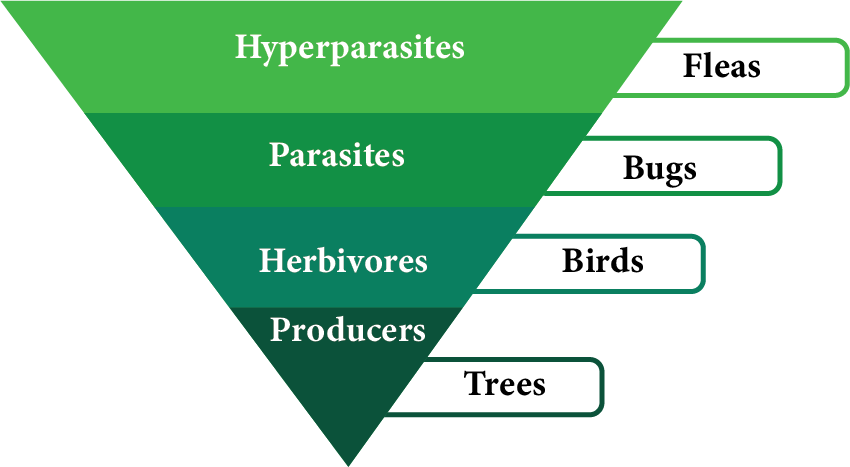
Inverted Pyramid of Numbers
Pyramid of Biomass:
A biomass pyramid is a graphical representation of the total organic matter or living biomass present in an ecosystem at various trophic levels.
The mass of life forms present at every trophic level in a given population is calculated as biomass. Dry weight in grams or calories per unit area are two ways to represent it.
The pyramid of biomass is upward (e.g. Terrestrial ecosystem) except for the ecosystems like oceans where a high number of zooplanktons rely on a low number of phytoplanktons.
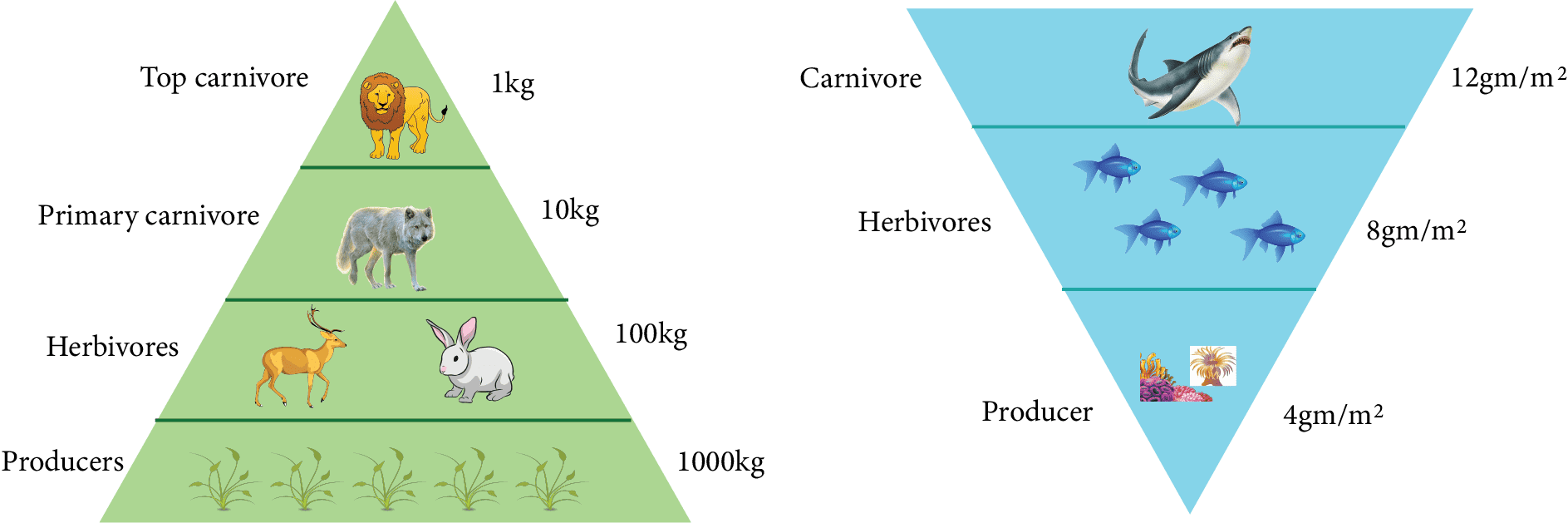
Upward (Left) and Inverted (Right) Pyramids of Biomass
Pyramid of Energy:
The energy pyramid is always upright.
This is because some energy is lost as heat when it moves from one level to another. It also implies that energy flow in a food chain is always unidirectional.
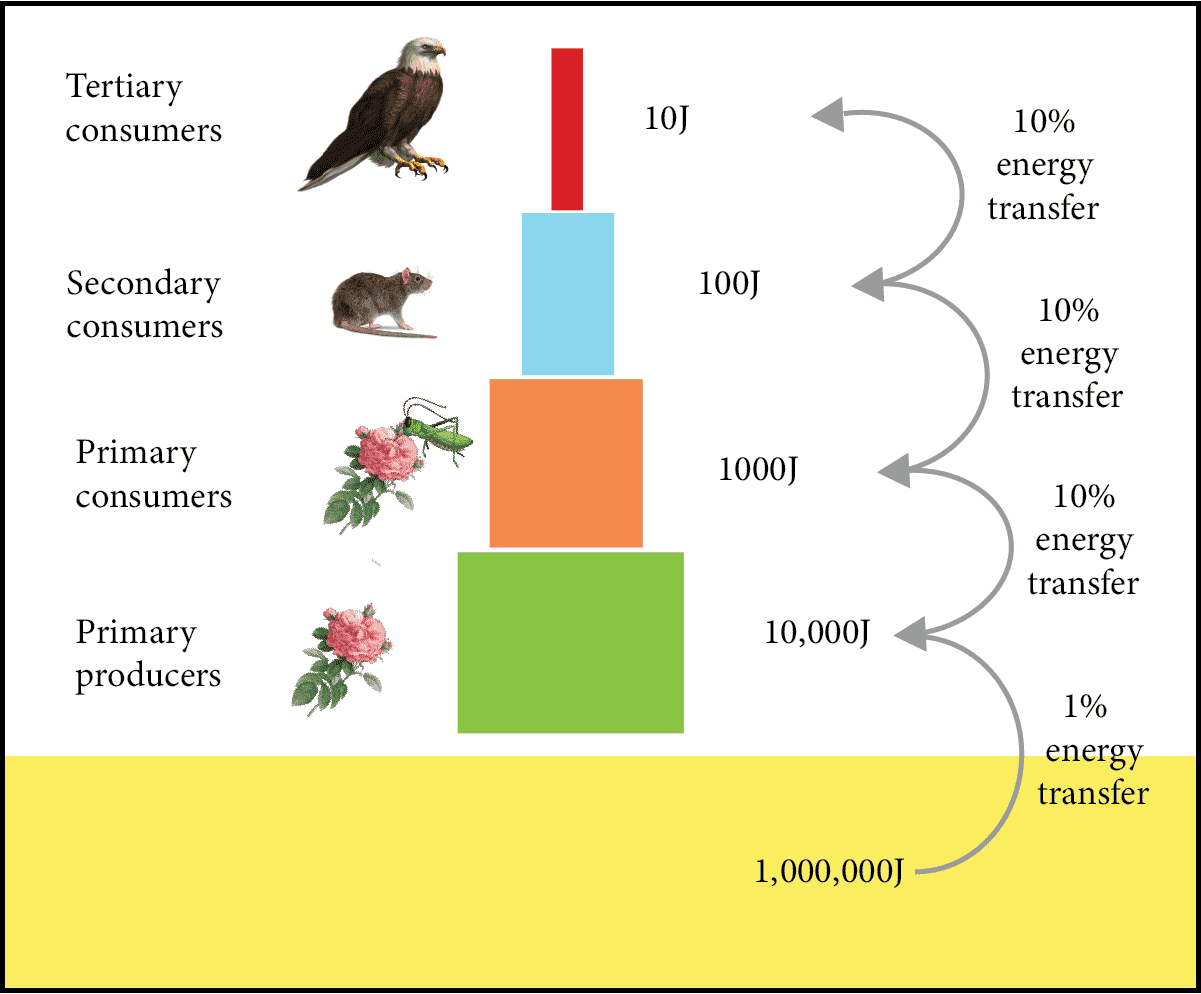
Pyramid of Energy
Ecological Succession
The practice of transformation in the structure of species that belong to an ecological community with time is known as ecological succession.
The time scale after a mass extinction can be centuries or sometimes millions of years.
This transition happens in a systematic and sequential manner, parallel to changes in the external environment.
Pioneer Species: These are the species that colonize a barren area.
Pioneer Community: A pioneer community is one that is capable of invading a bare area.
Climax Community: A climax community is a community that is almost at equilibrium with its surroundings.
Sere: A series of ecological communities that emerge in a given area, from the first pioneer community to the climax community.
A primary succession is a form of biological as well as ecological succession in plant life. It happens in an environment where a new substrate is being deposited. This new substrate is devoid of vegetation and other life forms. It is also usually devoid of soil and organic material. It can be found in places including land after a volcano or in the area left by a retreating glacier.
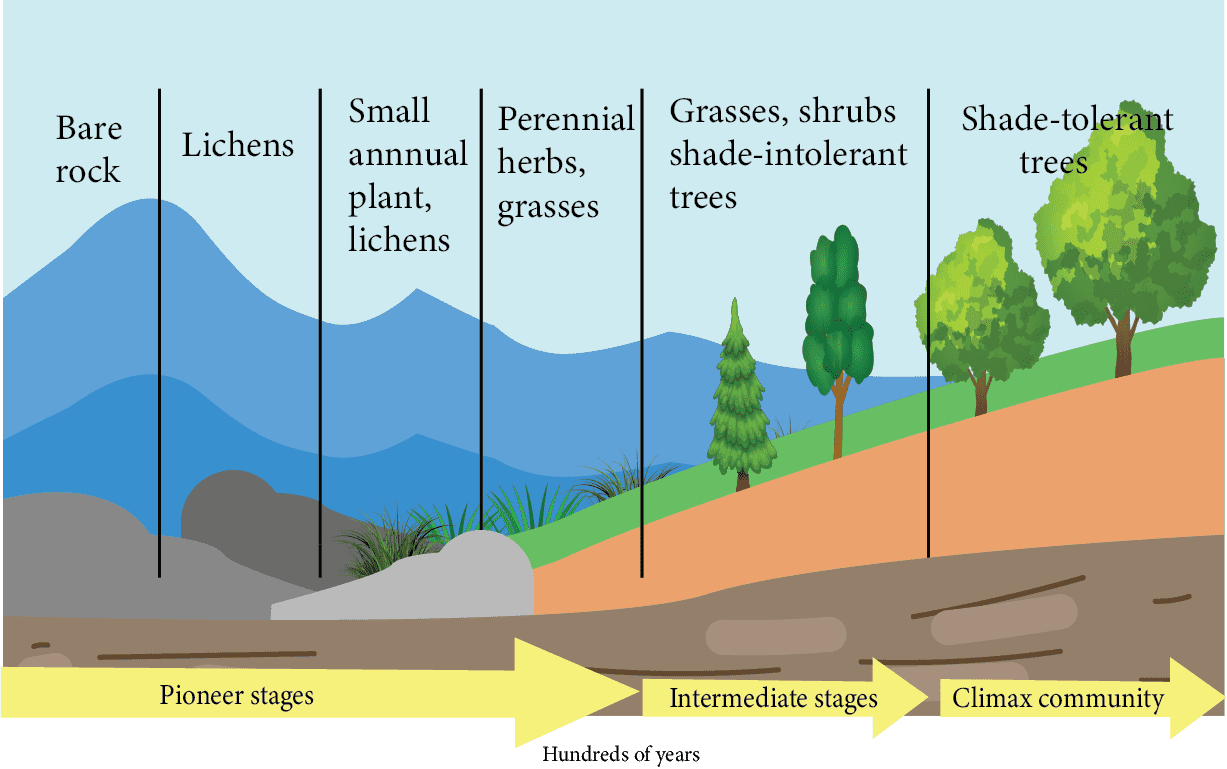
Primary Succession
Secondary succession is a kind of biological and ecological succession of plant species that occurs in an earlier populated but now disturbed or damaged habitat. For example, areas where current vegetation has been eliminated due to destructive events like fires.
It can also occur in an area where volcanic eruptions took place.
Plant Succession:
Hydrarch: Hydrosere or Hydrarch Succession is a succession that typically starts in a body of water or aquatic environment.
Xerarch: Xerosere is a type of succession of plants that are restricted in their water availability. It covers the various stages of xerarch succession. Xerosere is found in extremely dry environments including sand deserts, salt deserts, rock deserts, and so on.
The colonization of species in secondary succession is influenced by the supply of water, soil conditions, and the environment.
It also depends on the presence of seeds or other propagules. Because soil exists, the rate of succession is much quicker, and the climax community is attained much sooner.
Succession always follows the mesic community.
Nutrient Cycle
Nutrient cycling describes the flow of nutrients through the different elements of an ecosystem. It is also known as biogeochemical cycles where bio means living organisms and geo refers to the rocks, air, and water.
Nutrient Cycle Types:
(a) Gaseous
(b) Sedimentary
Standing State: The standing state is the total amount of various nutrients such as carbon, nitrogen, phosphorus, calcium, and so on that are present in the soil at a particular time. It varies depending on the type of ecosystem and the season.
The atmosphere acts as a storage area for gaseous nutrient cycles like carbon and nitrogen.
The earth's crust serves as a reservoir for the sedimentary nutrient cycle (sulfur, phosphorus, and so on).
Environmental factors influence the rate of nutrient release into the atmosphere.
The reservoir works to compensate for the deficit caused by inequality between influx and efflux.
Carbon Cycle:
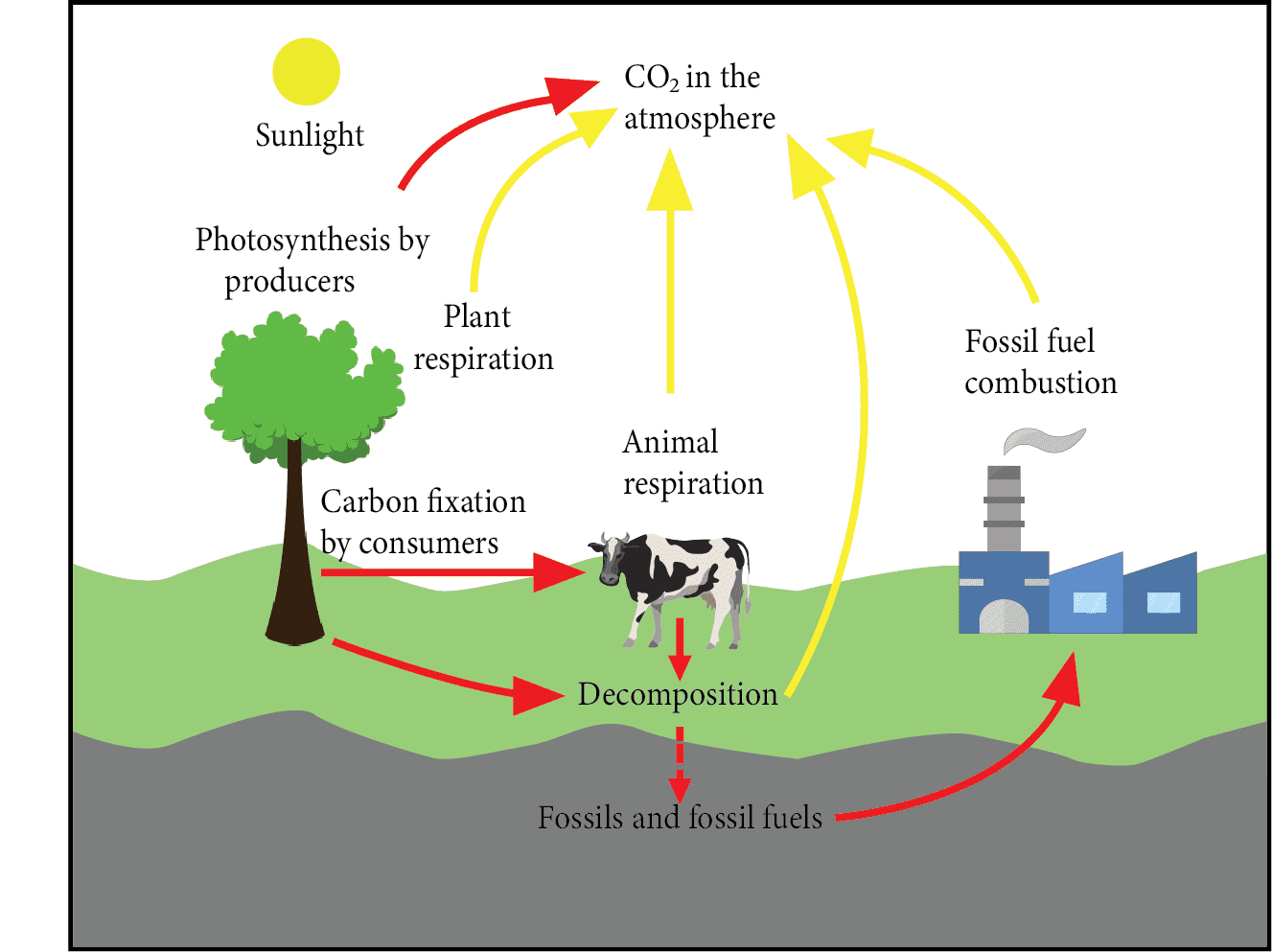
Carbon Cycle
The carbon cycle describes the flow of carbon through the ecosystem's various components.
Almost all the chemicals that constitute living tissue contain carbon.
When organisms die, the carbon they contain is recycled for future generations to use.
Carbon is discharged into the air as CO2 as an outcome of respiration and combustion.
Carbon dioxide is taken up by producers during the photosynthesis process, which results in the production of carbohydrates.
Producers are eaten by animals. Carbon is moved up and down the food chain due to the food chain. The majority of the carbon consumed is exhaled as CO2 during breathing.
Animals and plants will eventually die.
Decomposers consume and decompose dead organisms. As a result, the carbon in their cells is released into the surrounding air as carbon dioxide.
Decomposition is slowed in some unusual circumstances. The plant and animal content could then be converted into fossil fuel for future combustion.
Some of the carbon in marine animals' diets may be converted to calcium carbonate and then used to make their bodies' shells. These shells of dead animals accumulate on the seafloor over time and form or are converted into limestone. This limestone may ultimately become transmitted to the air due to different methods and activities of the earth, where it is exposed to weathering.
As a result, carbon dioxide is released back into the atmosphere. Volcanic activity also produces carbon dioxide.
Human activities have had a significant impact on the carbon cycle. Rapid deforestation and the widespread use of fossil fuels have accelerated the rate at which carbon dioxide is released into the atmosphere.
Phosphorus Cycle:
The phosphorus cycle is the procedure by which phosphorus travels through the atmosphere's different layers, which are the lithosphere, hydrosphere, and biosphere.
Phosphorus Cycle Steps:
Weathering of elevated rocks brings phosphates to the soil. Some phosphates eventually make their way back to the ocean.
Fertilizers: Phosphate fertilizers from fields may run directly into streams. These may eventually become members of a soil pool or be absorbed by plants.
Excretion and Decomposition: Animal excretion as well as animal and plant decomposition both generate phosphates on land and in water.
Dissolved Phosphates: Dissolved phosphates are important in the formation of ocean sediments through precipitation. The transformation of these sediments into phosphate rocks is a long and gradual process.
Geological Uplift: Geologic pressures can slowly lift phosphate rocks from the ocean floor or phosphate-rich rocks to form massive mountains.
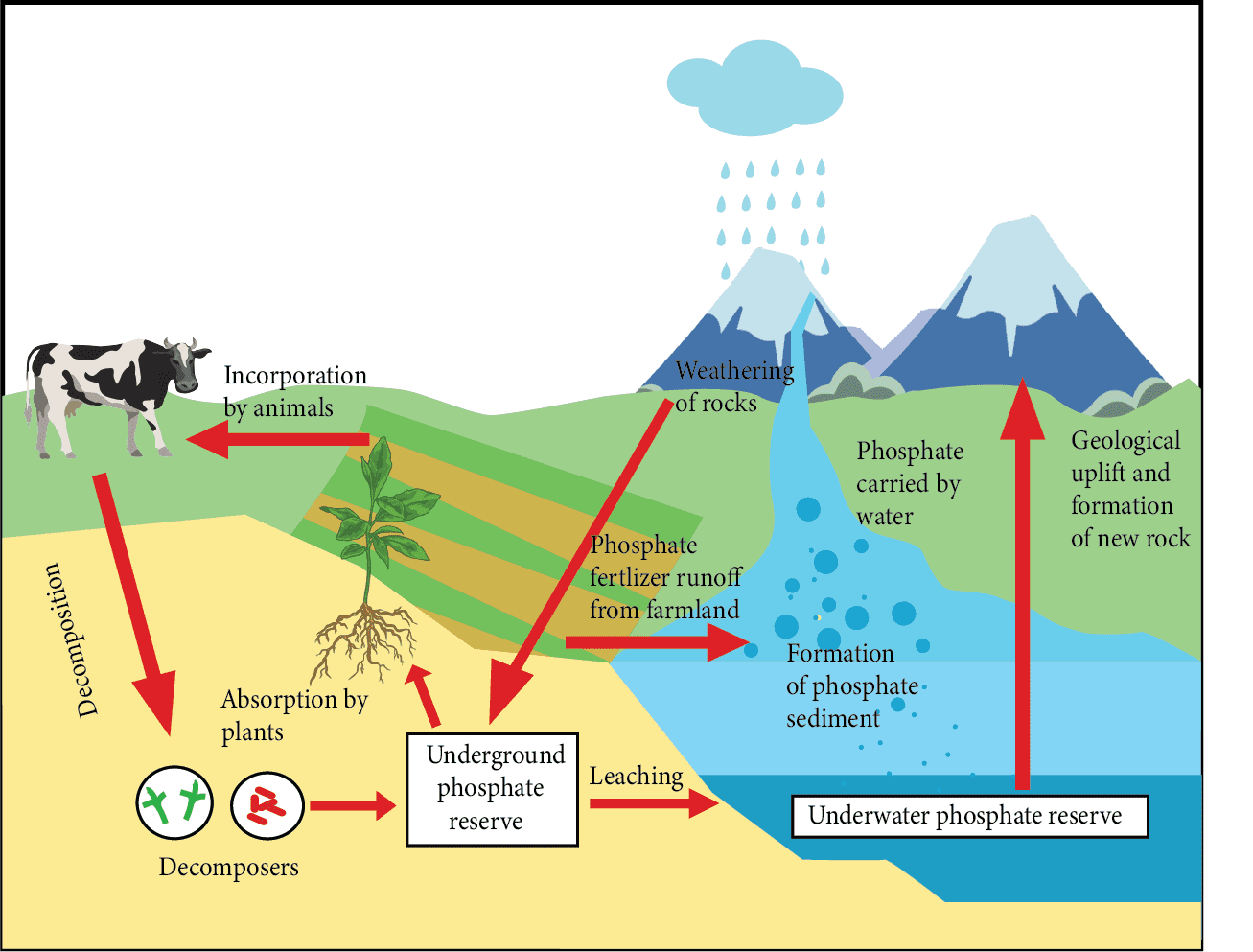
Phosphorus Cycle
Ecological Services
Ecosystem services are the results or outcomes of ecosystem processes.
Healthy Forest Ecosystem Services include:
Air and water purification
Drought and flood mitigation
Nutrient cycling.
Soil fertility creation.
Wildlife habitat creation.
Biodiversity preservation.
Crop pollination.
To provide a carbon storage site.
Providing aesthetic, ethnic, and spiritual benefits
The annual cost of all these ecosystem services is approximated to be US $ 33 trillion.
This is near twice the price of the global GNP (the US $ 18 trillion).
The Following is a calculation based on the total costs of different ecosystem services:
Soil formation corresponds to roughly half of all ecosystem services.
Recreation accounts for approximately 10% of the services.
Approximately 10% of them are nutrient cycling.
Climate control and habitat dark each cost approximately 6%.
Key Points to Remember:
An ecosystem is a natural structural and functional unit that includes both abiotic and biotic components.
Air, water, and soil are examples of abiotic components. Biotic components, on the other hand, are producers, consumers, and decomposers. Each ecosystem has a distinct physical structure as a result of the interaction of biotic and abiotic factors.
The two major structural characteristics of an ecosystem are species composition and stratification.
Every organism holds a place in an ecosystem based on its source of nutrition.
An ecosystem's four essential components are productivity, energy flow, decomposition, and nutrient cycling.
Primary productivity is the rate at which producers capture solar energy or produce biomass. There are two types: gross primary productivity (GPP) and net primary productivity (NPP)).
GPP is the rate of solar energy capture or total organic matter production. NPP is the leftover biomass or energy after producers have been used.
The rate of food energy assimilation by consumers is referred to as secondary productivity.
Decomposers transform complex organic compounds in detritus to carbon dioxide, water, and inorganic nutrients during decomposition. Decomposition consists of three steps: detritus fragmentation, leaching, and catabolism.
The flow of energy is unidirectional. Plants first absorb solar energy, and then food is moved from producers to decomposers.
In nature, organisms of various trophic levels are linked to one another for food or energy, forming a food chain.
Nutrient storage and movement through the different components of the ecosystem is referred to as Nutrient cycling. This process involves the repeated use of nutrients.
There are two types of nutrient cycling: gaseous and sedimentary. The reservoir for the gaseous type of cycle like the carbon cycle is the atmosphere or hydrosphere, whereas the reservoir for the sedimentary type is the Earth's crust, for example, phosphorus cycle.
Ecosystem services are products of ecosystem processes, such as forest purification of air and water.
The biotic community is alive and changing with the passing time. These changes are ordered sequentially and comprise ecological succession.
Succession begins with the invasion of a lifeless area by pioneers, which later pave the way for succession and, eventually, the formation of a stable climax community.
As long as the environment stays unchanged, the climax community remains stable.
Importance of Ecosystem Class 12 Notes for NEET
When students refer to the notes of the Ecosystem chapter of Class 12 Biology, they will have a complete understanding of the different aspects of our ecological system. The chapter also presents the concept of Ecological Pyramids which is a graphical representation of the ecological parameters presented in the sequence through various trophic levels. There are three different ecological pyramids-
Pyramids of Number
Pyramids of Biomass
Pyramids of Energy
Furthermore, Ecosystem notes also present the idea about ecological succession which is the gradual and fairly predictable change in the composition of species. The ecological succession is further divided into Primary Succession and Secondary Succession. Each aspect of the succession is presented finely in simple words by subject matter experts.
The Ecosystem chapter is very much important for NEET preparation. Students will get to learn about the Nutrient Cycle, Phosphorus Cycle, Carbon Cycle, and others. Upon reading notes, students will become capable of answering questions regarding the Ecosystem chapter that will help scoring high marks.
Benefits of Ecosystem Class 12 Notes from Vedantu
The Ecosystem notes for NEET PDF from Vedantu comes with many benefits. It is quite obvious that students come under a lot of pressure during the NEET exam which requires a lot of preparation. Using the PDF file that comes with handy information, you can prepare for the exam very well. Some of the benefits you will get are-
The Ecosystem notes Class 12 Biology PDF carries detailed explanation about the chapter and each section is finely elaborated.
These practice notes created for students carry the exact portion as per the NEET exam and all questionnaires are similar.
As mentioned above, these notes are created by subject matters of Vedantu who know what students need and how well they can prepare for the exam.
The revision note is compiled as per the latest NCERT syllabus of the chapter.
Download Ecosystem PDF Notes for Free
You can now download the Ecosystem PDF notes which are available for free covering all aspects of the chapter. Students can make use of these notes to understand the format so that you can remember everything. You can even test your exam preparation skills and practice giving answers to questions. To test your replying skills, use this Ecosystem Class 12 notes PDF file of the chapter and get insight of everything you should know to prepare.
NEET Biology Revision Notes -Chapter Pages
NEET Biology Chapter-wise Revision Notes | |
Ecosystem Notes | |
Other Important Links
Other Important Links for NEET Ecosystem |
FAQs on Revision Notes on Ecosystem for NEET 2025
1. What is the Ecosystem note all about?
The Ecosystem note is about the geographic area about plants, animals, and other living organisms. The note also comprises information on different forms of the bubble of life. It is quite an interesting part of the Class 12 topics.
2. What are the types of ecosystems?
There are different types which are based on nature, duration, and size. The Nature type consists of natural and human-made or artificial. Duration consists of temporary and permanent. Size consists of small/micro ecosystems and large/macro ecosystems.
3. What is decomposition?
Decomposition is the process of breaking down the dead organic into different groups of molecules and inorganic molecules. It is further divided into Detritus and Detritivores.
4. What are the two factors that affect decomposition?
Chemical Composition: In this, the decomposition rate is quite slow especially when the detritus is quite rich and the rate keeps on increasing when detritus is rich with nitrogen.
Climatic Conditions: In this, the warm and moist environment favours the decomposition and low temperature.



















